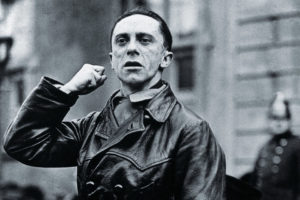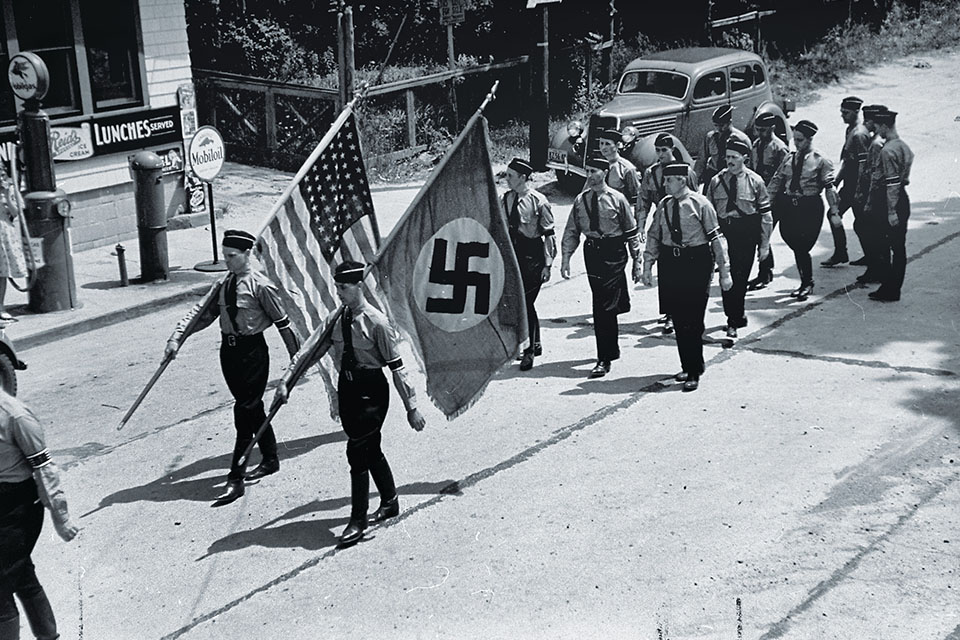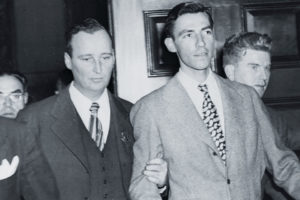In late 1944 U.S. Army Air Forces Lieutenant Martin James Monti stole a reconnaissance plane and defected to the failing Nazi cause—but why?
In the second episode of the acclaimed HBO miniseries Band of Brothers Pfc. Donald Malarkey questions a captured German sergeant in the liberated French village of Sainte-Marie-du-Mont. Malarkey is stunned to learn the enemy prisoner hails from a town in Oregon less than 100 miles from the GI’s own hometown. When asked how he ended up wearing a Wehrmacht uniform, the young POW replies that before America’s entry into the war his German-born parents had “answered the call” for “all true Aryans” to return to the Fatherland.
The encounter dramatized in the series actually took place and was not all that unusual. In fact, many German-born Americans returned to the Old Country in the years immediately preceding the 1939 outbreak of World War II—and more often than not the returnees took their American-born children with them.
After the war a folktale persisted that an entire unit in the German army—the so-called George Washington Brigade—comprised American defectors. While the brigade was a fiction created by the Waffen-SS for propaganda purposes, some Americans did serve Nazi Germany in uniform. Owing to poor records and scant postwar investigation, it is impossible to pinpoint an exact number. Of the handful of known individuals, however, none is more infamous than U.S. Army Air Forces fighter pilot turned SS officer Martin James Monti.
Born on Oct. 24, 1921, in Florissant, Mo.—a suburb of St. Louis—Monti was one of seven children born to second-generation Americans of Swiss-Italian and German descent. By all accounts an average kid, he was raised in an environment later described as fervently religious, strongly anti-communist, laced with isolationist sentiments and opposed to the tenets of President Franklin D. Roosevelt’s New Deal.
In the 1930s Monti—who had topped out at a strapping 6 feet 2 inches—became a devotee of suburban Detroit-based Roman Catholic clergyman Charles Coughlin, aka the “Radio Priest.” A bigot and zealot of the first order, Father Coughlin broadcast weekly sermons—railing alternately against communism, capitalism, Jews and Roosevelt while praising the national socialist regime of Germany’s Adolf Hitler and the fascist regime of Italy’s Benito Mussolini—to a listening audience that numbered in the tens of millions. So venomous were Coughlin’s broadcasts that the Roosevelt administration forced him off the air in September 1940, more than a year before the United States entered World War II.
But the Radio Priest’s sympathy for fascism was not unusual in prewar America. In early 1936 several small pro-Nazi organizations were subsumed into the newly created German American Bund, whose membership comprised mainly ethnic Germans living in the United States. The Bund was virulently anti-communist, anti-Semitic, opposed to Roosevelt’s policies and determined to keep America neutral in what was widely perceived to be a coming world war.
 The group’s führer was an outspoken German-born hatemonger named Fritz Julius Kuhn, who emulated Hitler’s frenetic style when addressing his minions. At its peak the Bund comprised an estimated 25,000 dues-paying members, some 8,000 of whom belonged to a subsect known as Sturmabteilungen, or Storm Troopers, whose uniformed ranks goose-stepped on parade through a number of major American cities, waving swastika flags, right arms extended in the Nazi salute. The Bund staged several demonstrations and rallies, one of which—held on Feb. 20, 1939, in New York City’s Madison Square Garden—drew some 20,000 attendees. Emulating Germany’s Hitler Youth movement, Bund leaders created indoctrination camps for white, non-Jewish and preferably “Aryan” children and adolescents. The Bund also published magazines, pamphlets and posters reflective in style and content of contemporary Third Reich propaganda.
The group’s führer was an outspoken German-born hatemonger named Fritz Julius Kuhn, who emulated Hitler’s frenetic style when addressing his minions. At its peak the Bund comprised an estimated 25,000 dues-paying members, some 8,000 of whom belonged to a subsect known as Sturmabteilungen, or Storm Troopers, whose uniformed ranks goose-stepped on parade through a number of major American cities, waving swastika flags, right arms extended in the Nazi salute. The Bund staged several demonstrations and rallies, one of which—held on Feb. 20, 1939, in New York City’s Madison Square Garden—drew some 20,000 attendees. Emulating Germany’s Hitler Youth movement, Bund leaders created indoctrination camps for white, non-Jewish and preferably “Aryan” children and adolescents. The Bund also published magazines, pamphlets and posters reflective in style and content of contemporary Third Reich propaganda.
Not surprising, a federal investigation—followed by a series of hearings by the House Un-American Activities Committee—revealed a strong connection between the Bund’s leadership and the government of Nazi Germany. Investigators also discovered Kuhn had been embezzling funds from his organization, a crime for which he was indicted, convicted and imprisoned. Authorities later stripped him of his citizenship, detained him as an enemy agent and then deported him. The organization continued to function, albeit in a diminished capacity, until December 1941, when the United States entered the war and immediately outlawed the Bund. Regardless, it is clear the sympathies of untold thousands of U.S. residents—both immigrants and native born—lay with Germany at the outset of hostilities.
Monti registered for the draft in June 1942, six months after the attack on Pearl Harbor, and shortly thereafter traveled to Detroit to visit with his idol, Coughlin. While their conversation went unrecorded, it would not be far-fetched to presume that the Radio Priest, ever critical of the Roosevelt administration, encouraged his young acolyte to give his support to Germany.
In late November, however, Monti enlisted as an aviation cadet in the U.S. Army Air Forces. By the summer of 1944 he had qualified as a fighter pilot in both the Lockheed P-38 Lightning and Bell P-39 Airacobra and risen to second lieutenant. That August the USAAF assigned Monti to the 126th Replacement Depot in Karachi, India (present-day Pakistan), where he soon earned promotion to first lieutenant. His next assignment would have been to a combat squadron had he remained in uniform. That is, an American uniform.

On Oct. 1, 1944—a few weeks shy of his 23rd birthday—Monti awoke, donned his uniform and initiated his complex plan to defect to the Germans. What followed was an odyssey of clever subterfuge on his part and a pattern of incredible gullibility and laxness on the part of the American military personnel with whom he came in contact. Monti’s first step: to get to the European theater and acquire a plane.
Though he carried no official travel orders, the young pilot first hitched a ride from India to Cairo aboard a Curtiss C-46 Commando transport, then caught a follow-on flight to Tripoli and, finally, talked himself aboard a plane bound for Naples, by then in Allied hands. On October 10, after hitching his way east from Naples, Monti arrived at the Foggia Airfield Complex, home to the USAAF’s 82nd Fighter Group, whose pilots included friends from flight school. Presenting himself to the commanding officer, he requested transfer and a combat assignment but was turned down.
Undeterred, Monti worked his way back west to Pomigliano Airfield, north of Naples, home to the 354th Air Service Squadron. It was that unit’s job to repair and test aircraft before shipment to various combat squadrons. On October 13, still lacking papers of any kind, Monti managed to pass himself off as a fighter pilot from the 82nd and requisition a Lockheed F-5E Lightning—the photo reconnaissance version of the P-38—for what he termed a “test flight.”
As soon as he was airborne, Monti set a course north for Axis-occupied Milan. There he turned over the plane and himself to the Germans, declaring his desire to serve the Third Reich and delighting his new hosts with the unexpected gift of an American Lightning in pristine condition. The Luftwaffe promptly replaced the aircraft’s U.S. markings with swastikas and a new call sign and sent it to Germany, where it served its new owners through war’s end.
Local German commanders were at a loss, however, about what to do with the Yank who had presented them with the Lightning. After briefly interrogating the young American, they sent him to a nearby POW camp. But an intercepted broadcast ordering Monti’s arrest soon convinced the Germans he was a legitimate defector. In November they sent him to Berlin, where SS-Haupsturmführer (Captain) Peter Delaney, an American defector from Louisiana, arranged for him to be enrolled in the SS-Standarte Kurt Eggers, a propaganda unit.
The Germans initially sought to use Monti as a radio propagandist. Milwaukee-born defector Howard Marggraff had successfully broadcast the Nazi party line for two years, and the Germans doubtless hoped the turncoat lieutenant would prove as gifted a speaker. Using an inflated rank and his mother’s maiden name, Monti began broadcasting as Captain Martin Wiethaupt. “Such material,” The New York Times later reported, “was…transmitted over the facilities of the German Radio Corporation to this country and to American combat troops in the European theater.” Monti’s rants, stemming from his youthful indoctrination and vetted by his handlers, centered on the theme that the United States should be fighting alongside Germany against Soviet Russia, the “true enemy of world peace.”
During the same period and from the same Berlin studio Portland-born defector Mildred Gillars was also spewing pro-Nazi propaganda. Gillars was a frustrated actress who made her way to Europe after failing to establish a theatrical career stateside. Arriving in Germany, she worked a brief stint as a language instructor before landing a job with Radio Berlin as an actress and announcer. After America entered the war, Gillars became something of a celebrity with her own propaganda show, Home Sweet Home. Directing her broadcasts at GIs, she tormented them with thoughts of the home front and family and scolded them in the sexiest of tones that they were fighting on the wrong side. Allied troops called her “Axis Sally,” among other less flattering names. (After the war she was arrested, charged with treason, tried in a U.S. court, convicted and sentenced to a long prison term.)
From the outset Gillars loathed Monti, voicing suspicion about the deserter’s loyalties and risking the wrath of the Gestapo by refusing to work as long as he remained on the air. Monti’s handlers were apparently more concerned with his dearth of talent, for after a handful of broadcasts they pulled him off the air and assigned him to write propaganda pamphlets distributed to American POWs.
By April 1945, with Nazi Germany on its heels and needing all available fighting men, SS-Untersturmführer (2nd Lt.) Monti was ordered to join his unit on the front in northern Italy. Shortly after his arrival in early May the American-born Waffen-SS officer in German uniform surrendered to the U.S. Fifth Army in Milan.
During his initial post-surrender interrogation Monti managed to convince his captors that although he had indeed gone AWOL and taken the plane, he had done so in order to wage a one-man war against the Germans, until being shot down. As for the Waffen-SS uniform, he claimed Italian partisans had given it to him to facilitate his passage back to Allied lines. His story ultimately fell apart, however, following his transfer to the custody of a military intelligence unit. In August he was court-martialed for being AWOL and for “misappropriation” of the F-5E Lightning, found guilty and sentenced to 15 years of hard labor. At that early stage prosecutors knew nothing of his defection or his propaganda activities on behalf of the Third Reich.
In early February 1946 President Harry S. Truman commuted Monti’s sentence to time served, contingent—in no small irony—on his re-enlistment in the Army Air Forces as a private. He did so and within two years had climbed to the rank of sergeant. Meanwhile, Army intelligence officials poring over captured records in Germany uncovered evidence of Monti’s contribution to the Nazi war effort. On Nov. 1, 1947, a Washington Post reporter broke the story, and military authorities detained Monti, although he remained in uniform. On Jan. 26, 1948, minutes after the Army granted Monti an honorable discharge at New York’s Mitchel Field, the FBI arrested him. After psychiatrists deemed Monti fit to stand trial, a federal grand jury indicted him for 21 overt acts of treason. The minimum penalty was a five-year prison term and a $10,000 fine; the maximum was death.
 Monti’s trial was set to begin on Jan. 17, 1949, at the U.S. District Court for the Eastern District of New York in Brooklyn. In preparation prosecutors flew in “several score” witnesses from Europe to testify. But on that opening day of his trial Monti surprised virtually everyone by pleading guilty to all charges. Judge Robert Alexander Inch balked at accepting his confession without further evidence and required that either two witnesses corroborate the charges or the defendant himself confess in open court. Monti willingly took the stand and, according to The New York Times, answered all the prosecutor’s questions “calmly in the affirmative.”
Monti’s trial was set to begin on Jan. 17, 1949, at the U.S. District Court for the Eastern District of New York in Brooklyn. In preparation prosecutors flew in “several score” witnesses from Europe to testify. But on that opening day of his trial Monti surprised virtually everyone by pleading guilty to all charges. Judge Robert Alexander Inch balked at accepting his confession without further evidence and required that either two witnesses corroborate the charges or the defendant himself confess in open court. Monti willingly took the stand and, according to The New York Times, answered all the prosecutor’s questions “calmly in the affirmative.”
Judge Inch then asked the defendant if he had acted voluntarily, and when Monti responded he had, the judge said, “That’s enough for me.” Monti’s defense attorney then launched into a 20-minute plea for leniency. When asked by Inch if he wished to make any sentencing recommendations, the prosecutor simply stated he would “rely upon the judgment” of the court, then reminded Inch, “This man did everything he could to commit treason; he left no stone unturned.” The judge agreed and imposed a prison sentence of 25 years and a fine of $10,000. Jailers returned Monti to the Manhattan House of Detention, from which authorities soon transferred him to the U.S. Penitentiary in Leavenworth, Kan., to serve his sentence.
In 1951 Monti appealed the verdict, claiming, among other grounds, he had not acted with “treasonable intent,” his attorney had coerced him into confessing, and the trial itself represented double jeopardy. The court found otherwise and reaffirmed the sentence. He appealed again in 1958, this time contending that “the court which pronounced the sentence which the defendant is now serving was without jurisdiction.” The court again denied his appeal, and Monti returned to Leavenworth. He was ultimately paroled in 1960, after serving only 11 years of his 25-year sentence. He returned to Missouri, where he kept out of trouble until his death on Sept. 11, 2000.
In their pretrial mental health evaluation of Monti the team of psychiatrists from Kings County Hospital in Brooklyn determined he possessed above-average intelligence, with an IQ of 131. They also found him to be narcissistic and immature with obsessive-compulsive and paranoid tendencies. But, they maintained, he was legally sane.
That leaves one nagging question: What would compel a bright and reportedly sane young U.S. Army Air Forces pilot to defect to the Germans at a point in the war when their defeat seemed all but imminent? Admittedly, in late 1944 Germany did manage to mount one last desperate offensive in the Battle of the Bulge, but by that juncture few savvy students of the war would have given the Nazis favorable odds on ultimate victory. Perhaps Monti’s warped ideology overshadowed his common sense, or perhaps serving the Nazi cause had been a long-standing dream he simply couldn’t give up. Whatever the reason, the man who had “left no stone unturned” in betrayal of his country became one of the most notorious of America’s World War II traitors.
Ron Soodalter is a regular contributor to Military History. For further reading he recommends Hitler’s Airwaves: The Inside Story of Nazi Radio Broadcasting and Propaganda Swing, by Horst J.P. Bergmeier and Rainer E. Lotz; Berlin Calling: American Broadcasters in Service to the Third Reich, by John Carver Edwards; and American Swastika, by Charles Higham.
First published in Military History Magazine’s January 2017 issue.





